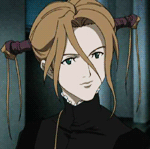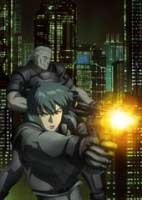May 2, 2005
Animation on television, child-safe and otherwise.
ZOINKS!Comic Book Properites, Animated
I don't watch many live-action cop shows — I was spoiled by Hill Street Blues in the '80s and Homicide in the '90s, and have never really had much interest in the current done-in-ones produced by Bruckheimer, Wolf, and their imitators. Give me ongoing plotlines, series-length arcs, and off-beat concepts any day of the week. Fortunately, two of Adult Swim's anime series1 offer that and more, even if their crime stories take place in unusual settings.
(And for those not familiar with Adult Swim, a reminder: Unlike some of the cartoons I've talked about in this column before, these aren't aimed at kids.)

|
The first handful of episodes beyond that have Robin (with her fire-based powers) meeting the other members of the team and hunting for witches to fight (a boy with telekinetic powers, a woman who controls voodoo dolls, et cetera). Almost all of these installments are relatively accessible, dropping only some very small hints about Robin's background (spent at an Italian convent learning her craft), and fleshing out the supporting cast. However, after ten episodes or so, the show steps things up, tossing out government conspiracies, a mysterious ancient witch who causes Robin to question what she's been taught, and an attack on the STNJ headquarters that forces Robin into hiding. The second half of the series turns into a fast-paced spy/crime story that easily gives Alias a run for its money. Spies and traitors are outed, the motives of the various government organizations and businesses behind the (literal) witch hunts are explored, and things rise to a climax, of course, with gun fights and explosions. I'm oversimplifying, but the second half of this series does a great job of tearing down the world so carefully built up in the first half.

|
But although it tends to set a slower pace than many cartoons (for every action-packed episode, there's another one that's almost nothing but dialogue) GitS:SAC ramps up the overarching plotline pretty quickly. A rogue hacker, going by the name "The Laughing Man," has resurfaced, and all attempts to track him and stop the chaos he spreads go awry. He hacks into other people's computers and cyberbrains to make them see a smiling face with a J.D. Salinger quote, and although wreaking havoc on the government is clearly a part of his agenda, his full motives (or even if it's really a "he") haven't been revealed.
As the team members (notably Kusanagi, male cyborg Batou, and the mostly-human Tosuga) go deeper after The Laughing Man, they get drawn into a police and government conspiracy that forces them underground. The series is barely halfway over, but has already shown itself to be as complex and layered as some of the hottest American shows right now. Of course, just as with Lost, I've got to wonder if the payoff will be worth the buildup (we've all been burnt by Twin Peaks), but in the meantime, this is one of the few shows (animated or otherwise) that I have to watch the second it hits my TiVo.
Both shows share a few other traits as well, including phenomenal music (both great scores and superb title songs, although WHR only has a song over the closing credits), an aversion to sentimentality, and a serious tone that could surprise casual anime fans, who might be used to copious comic relief in even "serious" sci-fi shows like Neon Genesis Evangelion. But in the end, what draws me to them is that they're just the two most interesting cop shows I've seen in a while.
1I know that there are plenty of anime snobs (and good old-fashioned foreign film snobs) out there who insist on watching these shows in their subtitled versions, but I'm writing this for SMRT-TV, which means I'll be discussing the dubbed versions shown on TV. Deal with it.
2Although most of the annoying tropes of anime — the misplaced silliness, the super-deformed heads, and the talking animals — are missing from this series, the inexplicable use of teens in adult settings remains, even though Robin could easily pass for 25 if they just changed one or two lines of dialogue.
Email the author.
All written content © 2005 by the authors. For more information, contact homer@smrt-tv.com
